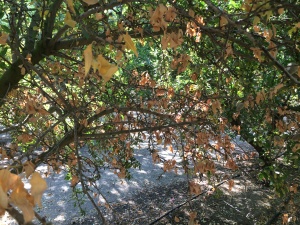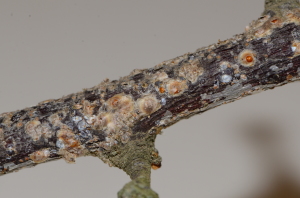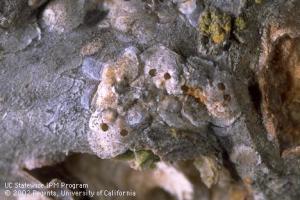Written by Gurreet Brar, UCCE Farm Advisor (Nut Crops), Fresno & Madera Counties

This summer we observed many cases of lower branch dieback in almond trees (like the one shown in picture). In many cases these symptoms were found to be associated with high scale populations. Diagnosis of such branches revealed that San Jose Scale and Walnut Scale caused lesions beneath the bark resulting in death of the tissue. These scales suck plant juices from the inner bark by inserting their mouthparts into twigs and injecting a toxin. When the populations become high enough, the numerous lesions may coalesce and cause the whole branch to die. Uncontrolled populations can kill branches within 1-3 years. San Jose Scale can be found on most, if not all, almond varieties. Walnut scale seems to like Monterey variety more than the others.
What it looks like? San Jose Scale is small (<1/16th” in diameter) and may have a white, black, or brown cap. Walnut Scale is grayish and is often found in daisy-shaped groups formed by scale coverings. When you lift off the covering from a female scale, the yellowish body is revealed underneath.

How to manage it? Normally, natural enemies keep the scale populations below economic damage threshold. However, a surge in scale population is usually associated with disruption in their biological control agents due to a shift in pesticide use trends. There can be up to 3-4 generations per year. Delayed dormant oil sprays can suppress scale populations and are less disruptive to natural enemies. Spring time applications of growth regulators are also effective while late summer to fall applications are not as effective.
Dormant spur sampling is important. A good management practice is to scout for the scale by doing dormant season spur sampling. If the dormant sampling results warrant a treatment, you can treat in the delayed dormant period according to UC IPM guidelines. During spur sampling, watch for any evidence of parasitization. Parasitized scales will have characteristic emergence holes in the body of dead mature scales. If a high degree of parasitization is observed, you may not need to treat during dormant period, as the parasites will keep the populations under check. In this case, delay the treatment until late spring when the crawlers emerge.

More information on Scale can be found at the UCIPM website. It has up-to-date treatments, describes scale monitoring during dormant and spring, and provides treatment thresholds.


Mark Brady
September 14, 2014As is the case in walnuts, a positive correlation of scale and Botryosphaeria infection, is there any possibility that in almonds this is not lower limb dieback and could be Botryosphaeria.
I’ve identified a fair amount of Botryosphaeria in almonds in the Kern County area which include the textbook gummosis with bands in the trunk and lower scaffold areas.
Mark Brady
mbrady@plantfoodsystems.com
559 731-1267
David Doll
September 14, 2014Mark,
There are many cases of lower branch death within almonds. They include shade-out, scale, and, as you highlighted lower limb dieback (LLDB). With LLDB, at one time Botryosphaeria was implicated as a possible cause, but further research failed to indicate pathogenicity. This suggests that other factors are at play with LLDB, with the current though being over-irrigation in the spring. This article discusses the more recent findings.
In regards to band canker and pruning wound cankers – yes these are caused by Botryosphaeria. You are correct in your description of the symptoms. More information on these can be found here.
It is true that there seems to be a correlation between scale infestation and Botryosphaeria infection within walnut. We have not identified this yet in almond. It appears that we have been failing to identify this pathogen in many of our orchards, and as a result, populations have built causing damage.
Thanks for the good questions. I hope that helps. If not, let me know.
David
Andre Tolmachoff
September 15, 2014Another great post. I noticed this in the orchard this year and was curious what it was. Now I understand it better. Thank You.
David Doll
September 15, 2014I agree, Andre – Gurreet did an excellent job on the article.
2015: Lower Limb Dieback Returns - The Almond Doctor
July 29, 2015[…] Walnut Scale can cause a gradual decline in wood vigor due to toxins being injected as they feed. Scale problems have become more of an issue in the past years due to lack of dormant sprays. Low rates of infiltration due to poor soil structure or compaction can lead to anaerobic […]